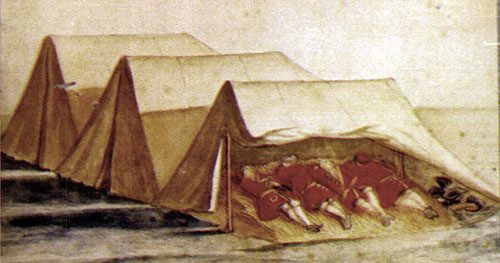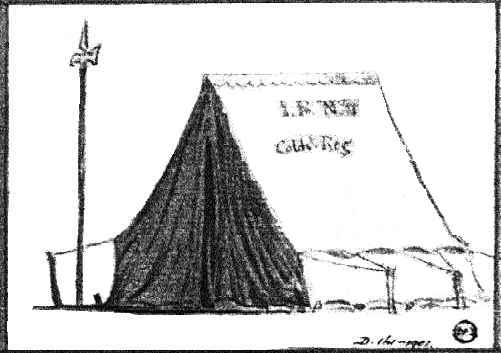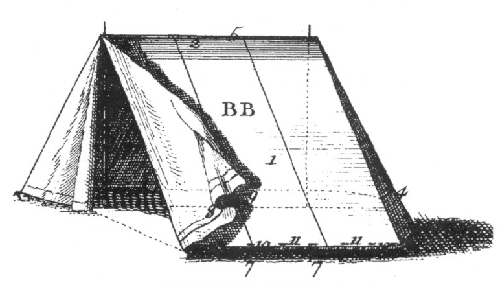

"Scenes of the Camp on Hampton Green 1781" (unattributed, Scottish United Services Museum). The image above depicts two men erecting a wedge tent. A set of upright and ridgepoles stand in the background, showing the tent’s supporting structure. The interior view (below) shows four men lying on a bed of straw. Their hats are visible in tent’s rear extension.


Coldstream Guards sergeant’s wall tent, Netherlands, circa 1748 (Thomas Sandby, artist. Courtesy of George Woodbridge; description from Sandby Drawings at Windsor Castle, A.P. Oppe (London, 1947) 47, item 156.) The ridge scallops are painted alternating colors (2 red, 2 blue, 2 red, etc.). Not shown are the privates’ tents behind this wall tent; those are numbered 1 B No. 2, 1 B No.3, etc.
American

Detail from watercolor panorama of Continental Army encampments at West Point, ca. 1782 (Pierre L'Enfant, artist, original in Library of Congress). In the distance are several rows of tents on Constitution Island. An excellent candid portrait of an officer, several non commissioned officers, and a group of soldiers is in the foreground. Some of the standing men wear knapsacks. Other soldiers are resting while their arms, with fixed bayonets, are stacked. The soldier second from the left appears to have a white service chevron on his coat sleeve. L’Enfant’s watercolor is featured in John Shy, ed., Winding Down - The Revolutionary War Letters of Lieutenant Benjamin Gilbert of Massachusetts, 1780-1783 (Ann Arbor, Mi., 1989), 96-97.

1. Side, overhead, and quarter views.
The illustrations showing the tent from three sides, the tent pole and the tent peg are from: M. de la Porterie, Institutions militaires (Paris, 1754).


2. Interior view.
French tents with an eight or nine man capacity were used by the Continental Army in 1782. “Plan pour faire voir la manier dont neuf Soldats sont couchez sous une tente.”(Translation, "A plan to show the way in which nine soldiers sleep in a tent."), M. le Maréchal de Puysegur, Art de la guerre par principes et par regles (Paris, 1748), plate 10.
Approximate tent dimensions: width, 9 feet 11 inches; length (from door to beginning of rear extension), 9 feet 8 inches; extension (bell) depth, 3 feet 5 ˝ inches (1 pied = 12 7/8 inches).French tent illustrations and information courtesy of André Gousse, Military Curator, Parks Canada. Plate description translation and French measurements courtesy of Robert A. Selig.